Dushyasana laughed at Yudhishtira for being a poor looser at the gambling table. Draupathi was dragged in from the middle of people behind whom she was hiding. She pleaded for mercy and begged hapless Yudhishtira for help. Her lips quivered, and her face shrunk. And years later, she pleaded Krishna not to help Pandavas reconcile, but to get them to war. Krishna remained calm and pleasant all through, his green face betraying no emotions. And in the ultimate war, Bheema was unstoppable. His face burned, eyes went red and his body trembled with anger as he searched for Dushyasala. And when Dushyasana fell, a raging Bheema drank his blood and pulled out the intestine with his canines.
Scenes from a Kathakali performance!
I was at a Kathakali performance organized by Bangalore Club of Kathakali and the Arts last weekend. Having got consent to shoot backstage, we arrived early and spent time watching the faces slowly come alive with colors. Here are some pictures and a few words. See more images on flickr group India Travel and Photography.
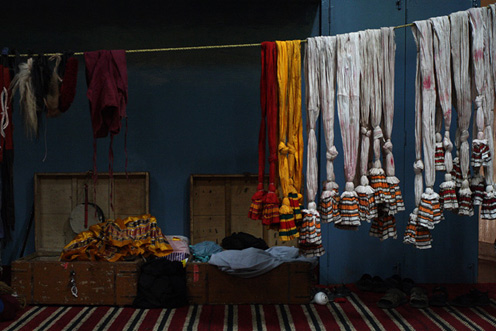
At the backstage
Preparing for the performance is a long process. The artists start applying colors on their face first, and then take help of a make-up person to give the final touches. Mixing colors started as early as 12pm for the show that was about to begin at 6.30pm. When we arrived at the scene around 2 o’clock, the greenroom was full with artists at various stages of colouring their face.

The artists relax before getting ready for the show
The day’s story was Duryodhana Vadham consisting four scenes. The first one is from the court of Dhritarashtra where Yudhisthira gambled away his clan and kingdom. The remaining scenes involved Krishna’s reconciliation efforts after the Pandavas return from exile, the war at Kurukshetra and Bheema’s revenge against Dushyasana and Duryodhana.
Our first introduction to the characters happened as the artists painted their faces with a brush in one hand and mirror in the other. Dushyasana – the evil – was painted in red(katti), while the good guys Yudhishtira and Krishna had fluorescent green (paccha) faces. Duryodhana, evil but royal, had a mix of both. Draupathi’s makeup had a fair face with long eyelashes, called Minukku.
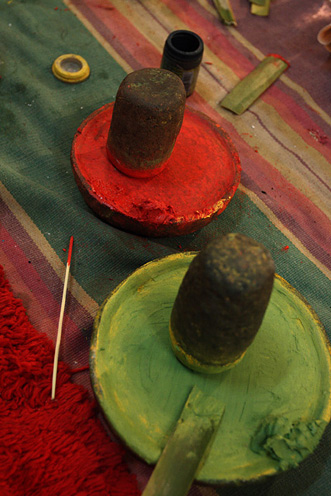
mixing the colors
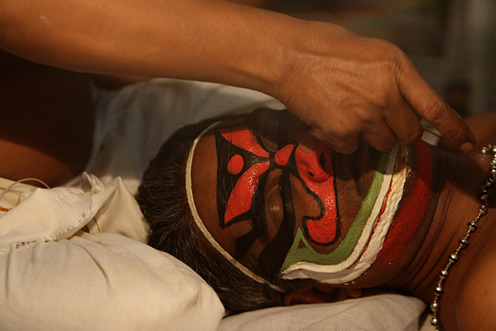
Duryodhana is a mix of katti and paccha
Kathakali evolved as an art form nearly four hundred years ago. It was then called Ramanattam, as the stories performed in those days were from the Ramayana. Achuthan Kutty, a retired scientist from BARC, now a connoisseur and artist, explained us with a child like enthusiasm on the intricacies of the art, about its history, the mudras and the rules of the performance.
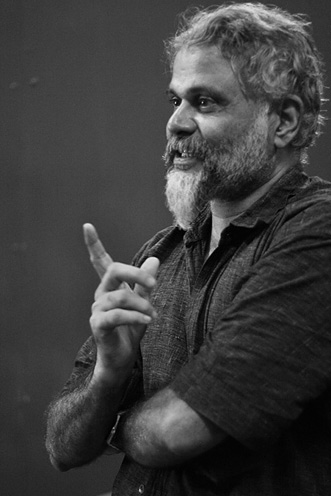
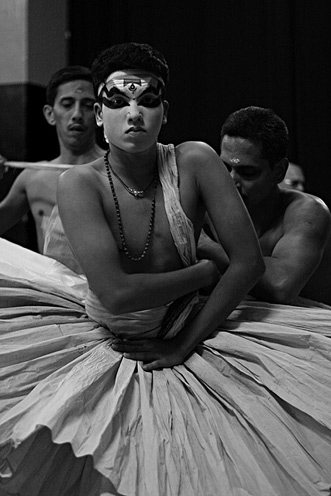
On stage, it was a dazzler of a performance. Two and a half hours went like minutes as the actors duly justified the characters they had become.
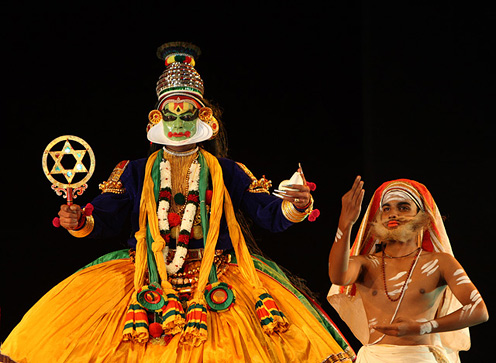
Krishna shows his Vishwaroopa
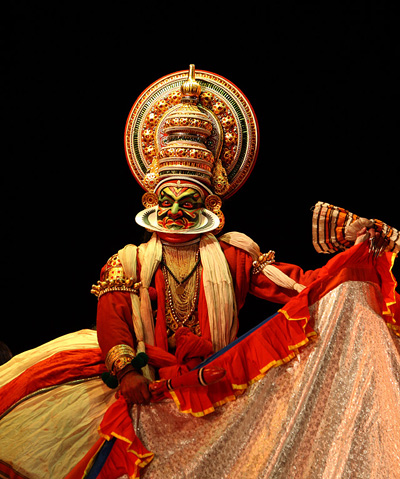
An angry Bheema searches for Dushyasana.
The show culminated with Bheema defeating and killing Dushyasana and Duryodhana in the battle.
See more images on flickr.
This happens to be the 500th post on India Travel Blog. A turtle dove in Keylong, Himachal Pradesh.
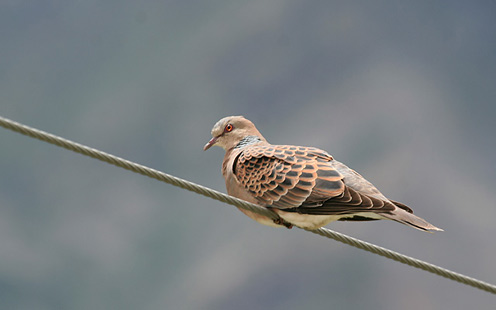
The second in the series on Thursday Travel Photography Column, discussing on the importance of early morning light.
Join India Travel and Photography group on flickr.
I have created a group on flickr, called India Travel and photography for discussions on travel and photography, and to share images and travel stories. Please join the group and share your images from recent trips, and possibly your travel stories along with images.
From next week, I intend to critique one or two images every week as a part of Thursday Travel Photography column, explaining how a photograph can be bettered and/or what makes it stand out, highlighting the technicals and aesthetics related to the image. To have your images critiqued, add your images to the group pool and tag them as itpcritique.
Waking up early in the morning is critical for getting good outdoor shots, especially when you are shooting landscape images. The soft light of the morning hours just before and during the sunrise can bring life to a scenery that may look flat in later hours of the day.
On a cloudy day or in clear summer days, the light just before the sun comes out tends to have a blue tint that works well when you are shooting in mountain landscapes, beach side or other open areas. In winters, the early morning sun on clear days tends to have an orange hue that can bathe the landscape in glorious colors. A gentle fog in the morning can diffuse the light and create magical effects in the landscape, highlighting the contours of the mountains and removing excessive details from the scenery. A few examples:
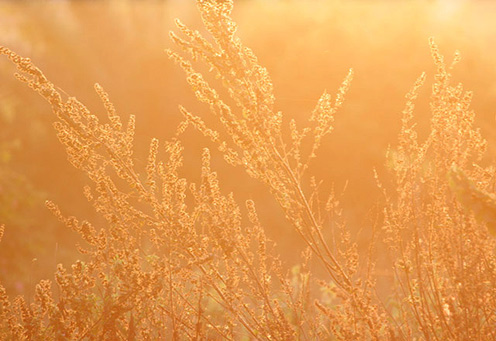
What could have been an ordinary image of wild grass is transformed into a colourful frame in early morning light, on a winter morning. But such brilliant colors may not occur in summers.
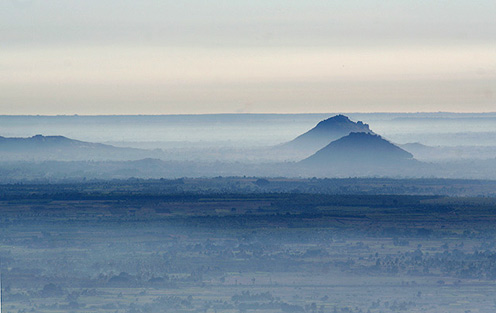
The mild fog in the morning hides the finer details of the plains and highlights just the contour of the mountains in this picture. Also notice the blue tint in the entire frame, which will not occur in the later hours of the day. A similar shot, made in the afternoon would be full of details of the plains, and the emphasis on the hills would be completely lost. Also, the image would have a dull color and would look very flat.
Another important character of the morning light is the angle of the incident light. Because the sun is close to horizon and the light is not harsh, sunlight casts mild shadows in depressions in the landscape. Shadows created by such lighting (normally called side-light) help highlight the texture of the subject and show the depth and help visualize the third dimension in the photograph. Contrary to this, afternoon sun has equal intensity in all areas, be it depressions or crests, making the scenery look flat and two dimensional. Where the afternoon light does cast shadows, the shadows tend to be harsh, which form completely dark areas in the image, making the picture look ugly. An example.

In the image above, which was shot in early morning hours, the distinction between each layer of mountains is clearly visible, and there is a depth in the image. However in the picture below, which was shot in the same region but in later hours of the day, distinction between the layers of mountains is not as prominent, and the image is not as appealing as the one above.
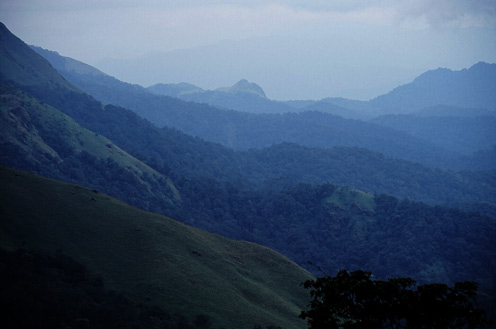
If you are shooting wildlife, there is another advantage besides the quality of light. Birds tend to be less active in the morning hours and are easier to shoot. You can find some birds, and animals like monkeys in a close huddle in winter mornings, which makes them look appealing, like in the image below.
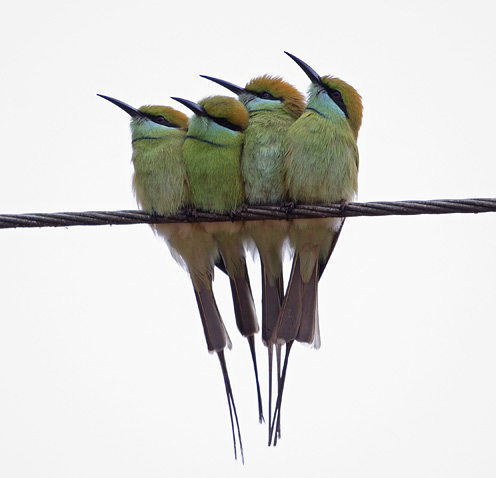
To ask me any questions on morning light or other aspects on photography, to start a discussion or share your images related to the topic, join India Travel and Photography flickr pool, add images and start discussion threads.













